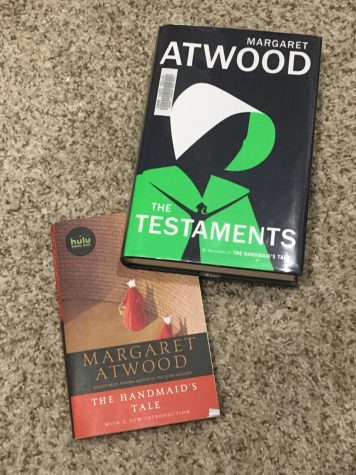Margaret Atwood returns with ‘The Testaments’
Author publishes sequel to ‘The Handmaid’s Tale’ 35 years later
October 23, 2019

Margaret Atwood’s original novel, “The Handmaid’s Tale” pictured with her sequel, “The Testaments,” published 35 years later.
Margaret Atwood’s 1984 “The Handmaid’s Tale” has done everything but fall out of popularity in the 35 years since its publication. The book was adapted into a movie in 1990, and more recently, an Emmy award-winning Hulu Original series came out starring the talented Elisabeth Moss.
In fact, 35 years after its publication, Atwood released a heavily anticipated sequel to “The Handmaid’s Tale,” titled “The Testaments,” which was released on Sept. 12, 2019.
“The Handmaid’s Tale” tells the story of Offred, a Handmaid forced to have children with the powerful men who are in charge of the theocracy, Gilead, that has replaced the United States. The novel ends on a cliffhanger, one that the Hulu show has extended past but that the novel’s sequel does not pick up.
“The Testaments” tells the story of three other women affected by the societal structure in Gilead, one that places women’s value upon their ability to be obedient and achieve motherhood.
One character, Aunt Lydia, is one of the few women in Gilead who has some type of power, albeit power over other women. She also appeared in “The Handmaid’s Tale,” though in “The Testaments,” her character appears to be less driven by the word of God and more influenced by the need to win leverage over her colleagues. The other two narrators, Daisy and Agnes, tell their stories of growing up in Canada and Gilead, respectively.
At the beginning of the novel, the three characters’ stories seem to not have much to do with each other. But this changes drastically as the story progresses.
“The Testaments” builds upon the world that Atwood created in her original novel and offers an abundance of commentary on the treatment of women in society, as well as the role that religion can play.
“The Handmaid’s Tale” is often cited by those wishing to protest proposed laws restricting reproductive rights and healthcare. This is due to the treatment of the Handmaids, where they are viewed as only having the purpose of procreation. However, “The Testaments” heavily explores the problems with expecting all women to marry and serve men, especially at an extremely young age. It also focuses heavily on the issue of hypocrisy and using religion to cover up indecent and criminal acts. In fact, several characters within the novel discover that what is written in The Bible has been altered in Gilead’s teachings to better fit the narrative that Gilead wants its citizens to believe.
Overall, “The Testaments” is a powerful and haunting read that holds its own next to its predecessor. It also brings new considerations from a trusted voice to the forefront of readers’ minds.
Though “The Handmaid’s Tale” and “The Testaments,” are fiction, they serve as a cautionary tale regarding the power that religion holds, which can easily become corrupt. The nation of Gilead, at its face, seems idealistic and pure, and this idea is expressed in “The Testaments” through the “Pearl Girls,” characters who are sent to other nations as missionaries. However, “The Testaments” also allows readers a glimpse into Gilead’s formation and crimes committed by its citizens, which are often covered up and discussed in secret. The character of Aunt Lydia describes it best when she writes that “Gilead is rotting.”
Currently, Hulu’s “The Handmaid’s Tale” is between seasons, with fans anticipating the production and release of season four. It has been rumored that “The Testaments” could influence the writing and the direction that season four may take as the show aims to expand its world-building even further.
Both “The Handmaid’s Tale” and “The Testaments” are well worth anyone’s read. This is especially true in an era where religion and morals are so often intertwined with politics and women’s reproductive rights are so often up for debate. It seems as though Atwood has come back 35 years later to remind us all that “The Handmaid’s Tale” is not just a cash cow and Emmy collector for Hulu, but a warning for the future.

















